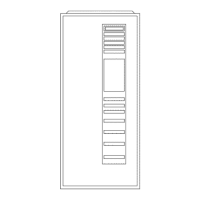18-1N. MINIMUM
TO BURNERS
Fig. 16--Installation in a Garage
A93044
-->
1¾"
1¾%,
A89014
Fig. 17--Leveling Legs
1. Position furnace on its back, Locate and drill a 5 16=in.
diameter hole in each bottom corner of furnace (See Fig. 17)
Holes in bottom closure panel may be used as guide locations.
2. For each hole, install nut on bolt and then install bolt and nut
in hole. (Install flat washer if desired.)
3. Install another nut on other side of fhmace base. (Install flat
washer if desired.)
4. Adjust outside nut to provide desired height, and tighten inside
nut to secure arrangement,
NOTE: Bottom closure must be used when leveling legs are used.
See Bottom Closure Panel section.
Step 2--hstallation in Upf!ow or Downflow
Applications
NOTE: For downflow applications, this furnace is approved for
use on combustible flooring when special base (available from
manufacturer) Paint No. KGASB020IALL is used. Special base in
not required when this J_ilrnace is installed on manu_hcmrer's (Toil
Assembly Part No. CD5 or CK5, or (oil Box Part No. K(AK( is
used,
1. Detem_ine application being installed from Table 1.
15
2 Construct hole in floor per dimensions specified in Table 1
and Fig. 18.
3. (onstruct plenum to dimensions specified in Table 1 and Fig.
18.
4. If downflow subbase (KGASB) is used, install as shown in
Fig. 19.
If (oil Asserubly Part No. CD5 or CK5 or (oil Box Part No.
KCAKC is used, install as shown in Fig. 20.
NOTE: Remove Nmace peKbrated, discharge duct flanges when
they interfere with mating flanges on coil on downflow subbase.
To remove fi/mace perforated, discharge duct flange, use wide
duct pliers or dtlct flange tool or hand seamers to bend flange back
and forth until it breaks off, Be careNt of sharp edges. (See Fig.
21.)
INIT MAY NOT OPERATE
Failure to %ltow this caution may result in intem_ittent unit
operation.
Do not bend duct flanges inward as shown in Fig 21. This
will affect airflow across heat exchangers and may cause limit
cycling or premature heat exchanger _hilure. Remove duct
flange completely or bend it inward a minimum of 210 ° as
shown in Fig 2!
NOTE: For 140 size unit when installed in downflow orientation,
cut the white jumper wire offbetween tem_inals PL1 =7 and PLI=9.
Do not cut white jumper between terminals PLI=7 and PL!-I 1.
Refer to Fig 30 %r location of jumper. Cut jumper close to
connector and remove wire to avoid a short circuit
Step a--installation in Horizontal Applications
INIT MAY NOT OPERATE
Failure to %ltow this caution may result in intem_ittent unit
operation.
The entire length of _/mace MUST be supported when
furnace is used in a horizontal position to ensure proper
&aining. When suspended, bottom brace supports sides and
center blower shelf When unit is supported fiom the ground,
blocks or pad should support sides and center blower shelf
area.
These t'umaces can be installed horizontally in either horizontal
left or right discharge position. In a crawlspace, fitmace can either
be hung from floor joist or installed on suitable blocks or pad.
Furnace can be suspended from each corner by hanger bolts and
angle iron supports. (See Fig. 22) (ut hanger bolts (4 each 3/8=in.
all-thread rod) to desired length Use 1 X 3/8-in. flat washers,
3/8=in tockwashers, and 3/8=in. nuts on hanger rods as shown in
Fig 22. Dimples are provided for hole locations (See Fig. 2)
Step 8--AIR DUCTS
GENERAL REQUIREMENTS
The duct system should be designed and sized according to
accepted national standards such as those published by: Air
Conditioning (ontractors Association (A(CA), Sheet Metal and
Air Conditioning Contractors National Association (SMACNA) or
American Society of Heating, Refrigerating and Air Conditioning
Engineers (ASHRAE) or consult :FiveAit' 5)'stems' Desigr* Gz¢ide-
[i_ve,sreference rabies available fi'om your local distributor. The
duct system should be sized to handle the required system design
CFM at the design static pressure.

